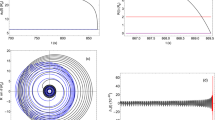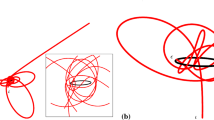Abstract
We summarize a scalar bimetric theory of gravity with a preferred reference frame. The dynamics are governed by an extension of Newton's second law. We recover geodesic motion together with Newton's attraction field in the static case and find Schwarzschild's metric in the static spherical case. We build asymptotic schemes of post-Newtonian (PN) and post-Minkowskian (PM) approximations, each based on associating a conceptual family of systems with the given system. At the 1PN approximation, there is no preferred-frame effect for photons, and we hence obtain the standard predictions of GR for photons. At the 0PM approximation, an isolated system loses energy by quadrupole radiation without any monopole or dipole term. Inserting this loss into the Newtonian two-body problem gives the Peters–Mathews coefficients of the theory.
Similar content being viewed by others
REFERENCES
C. W. Misner, K. S. Thorne, and J. A. Wheeler, Gravitation, Freeman, San Francisco (1973).
S. Carlip, Phys. Lett. A, 267, 81–87 (2000); gr-qc/9909087 (1999).
M. Arminjon, Rev. Roumaine Sci. Tech. Ser. Méc. Appl., 42, 27–57 (1997); http://geo.hmg.inpg.fr/arminjon/ pub list.html#A18.
M. Arminjon, Arch. Mech., 48, 25–52 (1996); http://geo.hmg.inpg.fr/arminjon/pub list.html#A15.
M. Arminjon, An. Univ. Bucuresti Fizica, 47, 3–21 (1998); physics/9911025 (1999).
M. Arminjon, Rev. Roumaine Sci. Tech. Ser. Méc. Appl., 43, 135–153 (1998); gr-qc/9912041 (1999).
L. Euler, Leonhardi Euleri Opera Omnia, Series Tertia, Pars Prima, B. G. Teubner, Leipzig und Bern (1911), pp. 3–15, 149-156.
M. Arminjon, “Remarks on the mathematical origin of wave mechanics and consequences for a quantum mechanics in a gravitational field,” in: 6th Intl. Conf. “Physical Interpretations of Relativity Theory” (London, 11-14 September, 1998): Supplementary Papers (M. C. Duffy, ed.), British Soc. Phil. Sci., London (1998), pp. 1–17; gr-qc/0203104 (2002).
C. Cattaneo, Nuovo Cimento, 10, 318–337 (1958).
A. A. Logunov, Yu. M. Loskutov, and M. A. Mestvirishvili, Sov. Phys. Usp., 31, 581–596 (1988).
A. A. Logunov and M. A. Mestvirishvili, The Relativistic Theory of Gravitation, Mir, Moscow (1989).
M. Arminjon, Phys. Essays, 14, 10–32 (2001); gr-qc/9911057 (1999).
L. D. Landau and E. M. Lifshitz, Classical Field Theory [in Russian] (Course of Theoretical Physics, Vol. 2), Nauka, Moscow (1967); English transl., Pergamon, Oxford (1975).
M. Arminjon, Arch. Mech., 48, 551–576 (1996); http://geo.hmg.inpg.fr/arminjon/pub list.html#A16.
S. Weinberg, Gravitation and Cosmology: Principles and Applications of the General Theory of Relativity, Wiley, New York (1972).
C. M. Will, Theory and Experiment in Gravitational Physics, Cambridge Univ. Press, Cambridge (1993).
M. Arminjon, “Equations of motion of the mass centers in a scalar theory of gravitation: Expansion in the separation parameter,” Romanian J. Phys. (to appear); gr-qc/0202029 (2002).
M. Arminjon, Internat. J. Mod. Phys. A, 17, 4203–4208 (2002); gr-qc/0205105 (2002).
T. Futamase and B. F. Schutz, Phys. Rev. D, 28, 2363–2372 (1983).
M. Arminjon, Romanian J. Phys., 45, 389–414 (2000); gr-qc/0003066 (2000).
H. Stephani, General Relativity, Cambridge Univ. Press, Cambridge (1982).
V. A. Fock, The Theory of Space, Time, and Gravitation [in Russian], Fizmatlit, Moscow (1961); English transl., Pergamon, Oxford (1959).
T. Damour and B. Schmidt, J. Math. Phys., 31, 2441–2453 (1990).
T. Damour, “The problem of motion in Newtonian and Einsteinian gravity,” in: Three Hundred Years of Gravitation (S. W. Hawking and W. Israel, eds.), Cambridge Univ. Press, Cambridge (1987), pp. 128–198.
J. H. Taylor and J. M. Weisberg, Astrophys. J., 253, 908–920 (1982).
N. Rosen, Ann. Phys., 84, 455–473 (1974).
Rights and permissions
About this article
Cite this article
Arminjon, M. Gravitational Effects on Light Rays and Binary Pulsar Energy Loss in a Scalar Theory of Gravity. Theoretical and Mathematical Physics 140, 1011–1027 (2004). https://doi.org/10.1023/B:TAMP.0000033037.42732.c5
Issue Date:
DOI: https://doi.org/10.1023/B:TAMP.0000033037.42732.c5




